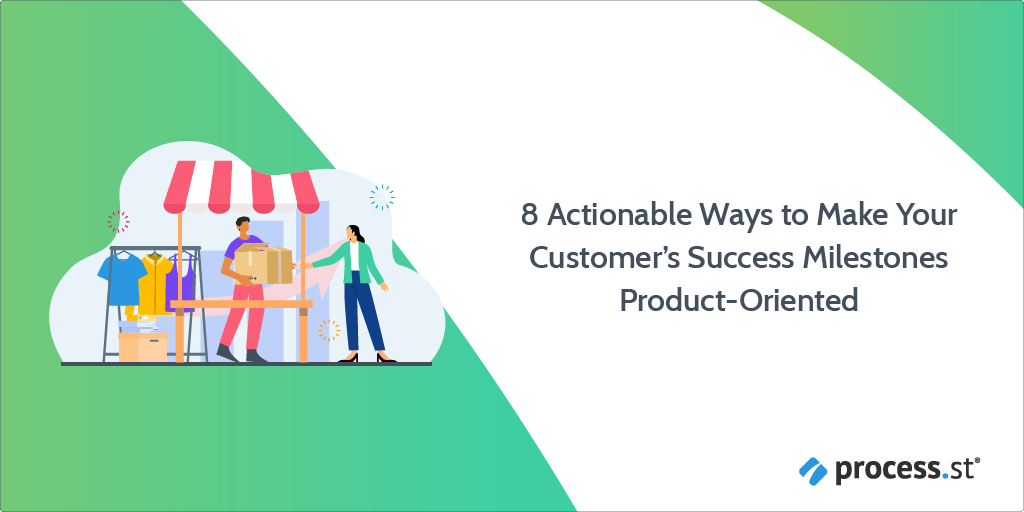
According to a 2020 Walker study, 86% of buyers will pay more for a better customer experience.
Customer experience is a key brand differentiator, and getting it right can determine the difference between success and failure.
In this Process Street article, we examine a customer-centric approach and explain how you can use it to be more product-oriented. That is, you’ll learn how to focus on the customer’s experience when using your product.
Taking a product-oriented approach to provide a great customer experience will set you apart from your competition, and give you the edge you need to succeed.
You need to be thinking about your customer and how they interact with your product to draw appropriate customer success milestones. Following the 8 steps in this article will help you do that.
By the end of this article, you’ll have customer-success milestones that act as a guide for the delivery of an exceptional in-product user experience.
- Rising to the digital transformation and why you need to be product-oriented
- How to track the customer journey
- 8 actionable steps to make your customer success milestones product-oriented
Rising to the digital transformation and why you need to be product-oriented
Between 2000 and 2014, 52% of the Fortune 500 companies disappeared.
They either went bankrupt or were acquired.
You see, these companies failed to adapt and respond to industry changes. One major industry change to note is the advancement of technology in business.
To put this advancement into perspective, think back to your first computer. As Salim Ismail explains:
“10 years ago a $1000 laptop had the computing power of an insect.
2020, it has the computing power of a mouse.
In 2030, the same laptop will have the computing power of the human brain.
2055 and laptops are estimated to have the computing power of the entire human species. – Salim Ismail, Singularity University and Deloitte in the Netherlands
(If your reading this article in 35 years, get back to me on this one )
48% of 2000’s Fortune 500 companies were winners. They adapted and worked with the changes brought by technology. Those that didn’t adapt languished.
Thinking on this, one major change to come from a digital transformation is the subscription-based business model. This is a model open to variations, such as Infrastructure-as-a-Service (IaaS) and Data-as-a-Service (DaaS). What’s key to note is how this change has altered customer experience, engagement, and hence expectations. According to Deloitte, this is the biggest disruptor for businesses today.
Once more, research shows that 70-90% of the buyer’s journey is completed before engaging a salesperson. This is due to the wealth of content and information available online. We’re talking about social media channels, review sites, easy access to competitor information, and price-comparison tools.
As such, it’s no longer an effective strategy for SaaS businesses to compete on features and pricing. Your competitors can match your prices, copy your features, and mirror your marketing message.
You need to be part of the third wave of SaaS, one that competes on customer experience.
You see, delivering an exceptional experience is hard to copy. Also, note that 30% of your customers are willing to share bad experiences. With this in mind, its clear that focusing on customer experience is a no-brainer.
Why you need to be product-oriented to have a customer-centric approach
To create a competitive edge by delivering excellent customer experiences, you need to re-design your organization from the core. Successful companies think about customer experience as a corporate-level strategy impacting every aspect of a business. This means your product too.
To be competitive at the customer experience level, you need to create a product that empowers users. That is, let your product do the talking. This product-led approach means tracking and measuring in-product customer behaviors and correlating them across the customer lifecycle.
There are two actions you need to do:
- Document your customer’s lifecycle.
- Map product-led customer success milestones.
What is a customer success milestone?
A customer success milestone is an action that, once completed, takes the customer towards their ever-evolving desired outcome.
The word customer indicates the customer-centricity of these milestones. In this article, you’ll learn how to make these product-oriented too.
How to track the customer journey
To understand how to track your customer’s journey, let’s run through a hypothetical scenario using Process Street.
Hypothetical scenario – Bruce Wayne
Action-man Bruce Wayne arrives at Process Street‘s homepage. From here, Bruce requests a demo but then disappears having been called on an urgent mission. We all know how busy Bruce is, so we at Process Street send an email reminder for him to sign up for our free trial.
Bruce opens the email but doesn’t return to Process Street.
Two days later, we send another email reminder to Bruce. We’re confident our service will help Bruce better organize his life and work.
This time, Bruce returns to
Once signed up, we’re able to track Bruce’s product usage and optimize his engagement. We work with Bruce to understand his goals and map these onto his lifecycle.
An overview of Bruce’s journey is given below:
- Bruce came across one of Process Street’s top articles from our blog.
- Bruce then visited Process Street’s homepage.
- Bruce requested and completed a product demo.
- After a few iterative reminders, Bruce signed up for Process Street’s free trial.
- Bruce set up his Process Street account.
- Once Bruce reached his first goal with Process Street, he upgraded his account.
The figure below represents the step-by-step customer journey for Bruce. It should be noted that Bruce’s experience with Process Street took place outside the product, up to the point where Bruce requested a Process Street demo. Experiences were then in-product. Your aim is to reduce the number of out-product experiences and shorten the time before an in-product experience. This means the experiences you’re providing are product-oriented.
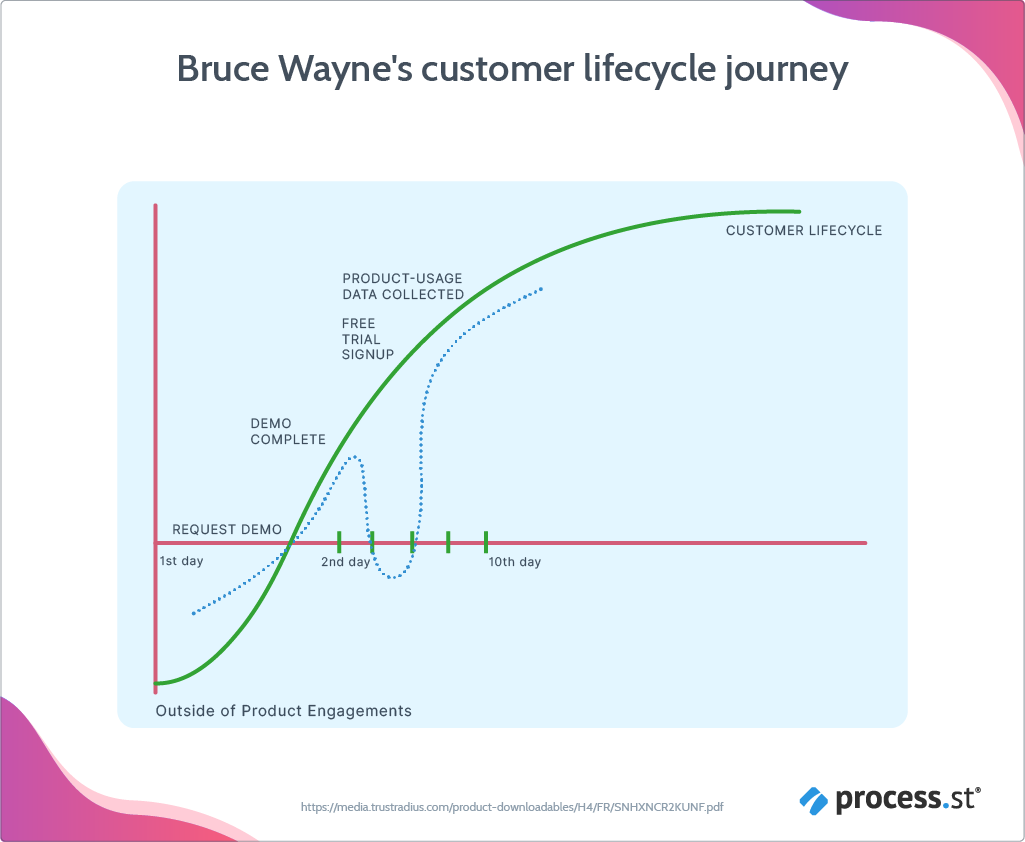
The green line on the image above represents the ideal journey, from an out-product to an in-product experience. In Wayne’s case, he didn’t complete each milestone consecutively with no hiccups/delays. This lengthened his out-product experience time. Note the drop in engagement as Bruce took longer than expected to sign up for the free trial.
Once a customer is experiencing your product, your milestones must help them realize true product value. I.e. it’s all about your product, and your milestones need to be product-oriented.
Map a customer’s milestones onto the lifecycle you’ve laid out.
8 actionable steps to make your customer success milestones product-oriented
Execute the below 8 actions to ensure your customer success milestones are product-oriented.
Step #1: Define your personas
To be product-oriented, you must have an accurate and deep understanding of your users and their needs. How can you know your customer’s goals without understanding their pain points?
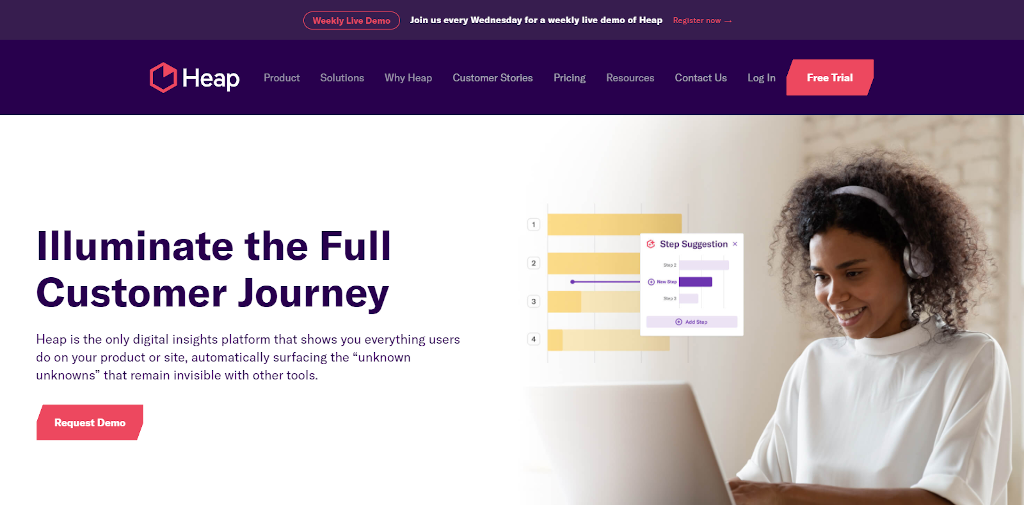
Take the digital-insights platform Heap as an example. As Matin Movassate, founder and chairman at Heap states…
“We know that the most successful buyer persona for Heap is someone who wants to make their organization data-driven…Basically, we try to build intuitive tools that serve the needs of about 80% of our user base. The other 20% includes developers and data scientists who we serve through robust APIs, good documentation, and customer success” – Matin Movassate, Product-Led Growth Playbook
First, define your ideal customer profile. This is a description of a hypothetical company or customer account that would benefit from your product or service the most. For instance, Process Street’s ICP is a software or services company located in the USA, Canada, Australia, or the UK with over 50 employees.
Next, start detailing your personas. Each persona will deviate from your ideal customer slightly. Think about your persona’s age, gender, location, income, and education.
Once you’ve defined your personas, it’s your job to map their pain points and identify their goals. Think about what motivates this type of person, and where they’re trying to get to.
Then establish what they value and what they fear. What scares this type of customer? What’s stressing them out?
Then build the customer profile by uncovering their biggest pain points. What problems or hassles is this person trying to solve? What challenges does your product help eliminate? What features will give your target audience the most value?
For more information on how you can define your customer personas, read: Reach the Right People & Get the Right Result With a Customer Profile
Step #2: Map golden feature adoption as a key success milestone
Value features, otherwise known as golden features, help your prospect recognize product value. This means they can advance to the next stage of the customer lifecycle.
During the customer acquisition and adoption phases, value features guide prospects through a product’s core use case. Prospects that adopt golden features are more likely to convert to customers. Take your customer’s profile and their mapped pain points, and identify which product feature will solve each pain point.
For instance, let’s say you offer a CRM solution for customer success professionals. You’ve mapped their persona and identified their biggest pain points. One is a lack of time and over-stretched workloads. You know your automation feature will help your persona address these pain points. Adoption of this feature is a key customer success milestone. Map this milestone onto your customer’s journey, and provide the education and resources needed for your customer to achieve it.
Step #3: Choose customer milestones that deliver new value
Hitting a milestone should feel like a completed task for your customer. Every milestone should offer new value mapping a customer’s value-realization path.
Make it easy for people to use your product. You want them to receive product value before the paywall sets in. Therefore, your first milestones should guide your prospects to sign-up for a free trial or freemium product version. Remember, you want to decrease the time between an out-product and an in-product user experience. Offering free trials/freemium versions is a great way to do this.
According to Nuance Enterprise, 67% of customers prefer a self-service option. In reaction, companies can improve customer experience and increase profitability with free trial options in the buying process.
Free trials and freemium versions are strategies that captured my attention. I recently signed up for the mobile application downward dog as part of my ongoing – but rarely successful – attempt to do more yoga. I didn’t want to commit to making a payment before I knew I’d get round to using the app. The free version gave me a chance to trial the application. The 20-minute practices suited me perfectly, and after a few weeks, I decided to make the leap and sign-up for a paid subscription.
Use free trials and freemium versions to show the value of your offering, and bring your customers to their first a-ha moment.
The next logical milestone would be to move your customers from the free trial the paid product version.
Include relevant onboarding experiences tailored to the user’s role, and what that person is trying to accomplish with your product. If a customer abandons the free trial, send out a follow-up email to encourage continuation. Make all communications personal for an exceptional customer experience – after all, this is how you’re going to stand out in the over-crowded digital market.
For more information on how to write a follow-up email, read: How To Write Follow Up Emails: Templates, Processes, and Guides.
Include features in paid plans that your persona is willing to upgrade to have access to. Track your customer’s in-product behavior to identify when a user is willing to pay up.
The idea is that you grow accounts over time with value metrics and packages that naturally scale as customers become hooked on your product.
Step #4: Use velocity metrics to measure how long it takes a customer to achieve each milestone
The time it takes a prospect to move through the customer lifecycle, from one milestone to the next, is a vital factor to consider and prioritize.
The shorter the time to value, the greater the probability of a closed deal and customer loyalty.
Being product-led and customer-focused demands cross-functional teamwork, to reduce the time from when a prospect becomes familiar with your company, to the time they make a purchase.
E.g. A velocity metric could be the average number of days it takes a prospect to move from their free trial to becoming a PQL.
Velocity metrics help organizations forecast revenue. In addition, they help businesses determine which part of the lifecycle is the longest and how to shorten it. Velocity metrics also indicate where a customer is heading – i.e. what milestones do they want to achieve and how long will it take them to achieve them?
Think of velocity metrics as customer success vectors. For more information on what customer success vectors are and how to implement them read: 5 Tips to Make Your Customer Success Vectors Actual Vectors (KSIs Not KPIs)
When mapping your customer success vectors, consider each customer milestone and its associated revenue stream. Map revenue against time to detail the direction your customer is heading, and how fast they’ll move from one milestone to the next. You want to keep your customers following a positive metric path (as per the image below), with each successive milestone representing new value for both you and your customer.
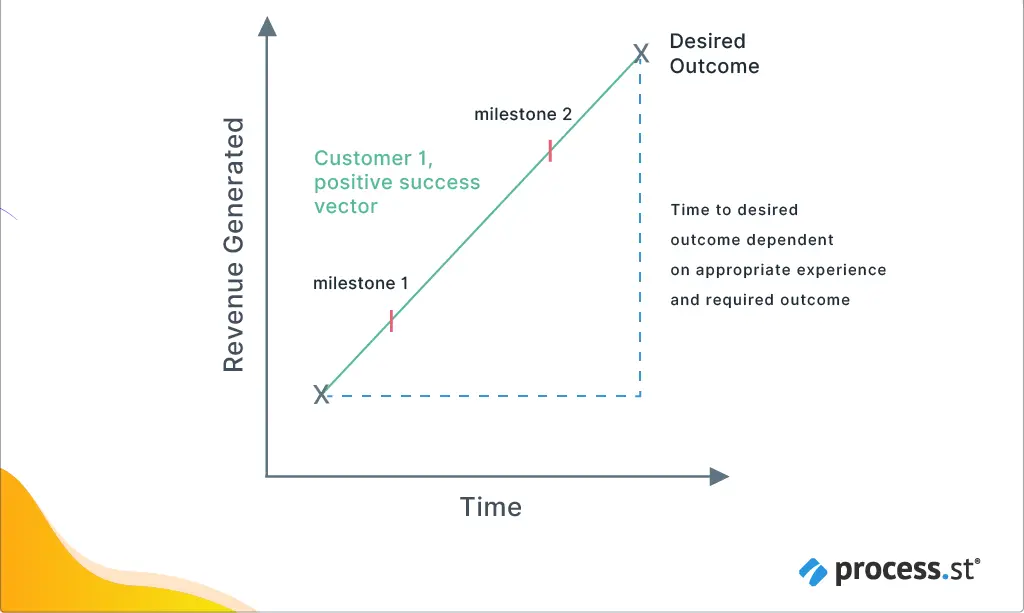
To improve your velocity metric measures, remove complexity and limit the number of steps needed to complete a milestone. Simplify your customer journey to ensure nothing distracts prospects from achieving their product goals.
It’s recommended that you limit milestones to 5-7 steps, and guide your prospects with personal and simple messages. Minimizing the number of options will help prevent decision paralysis and customer dissatisfaction.
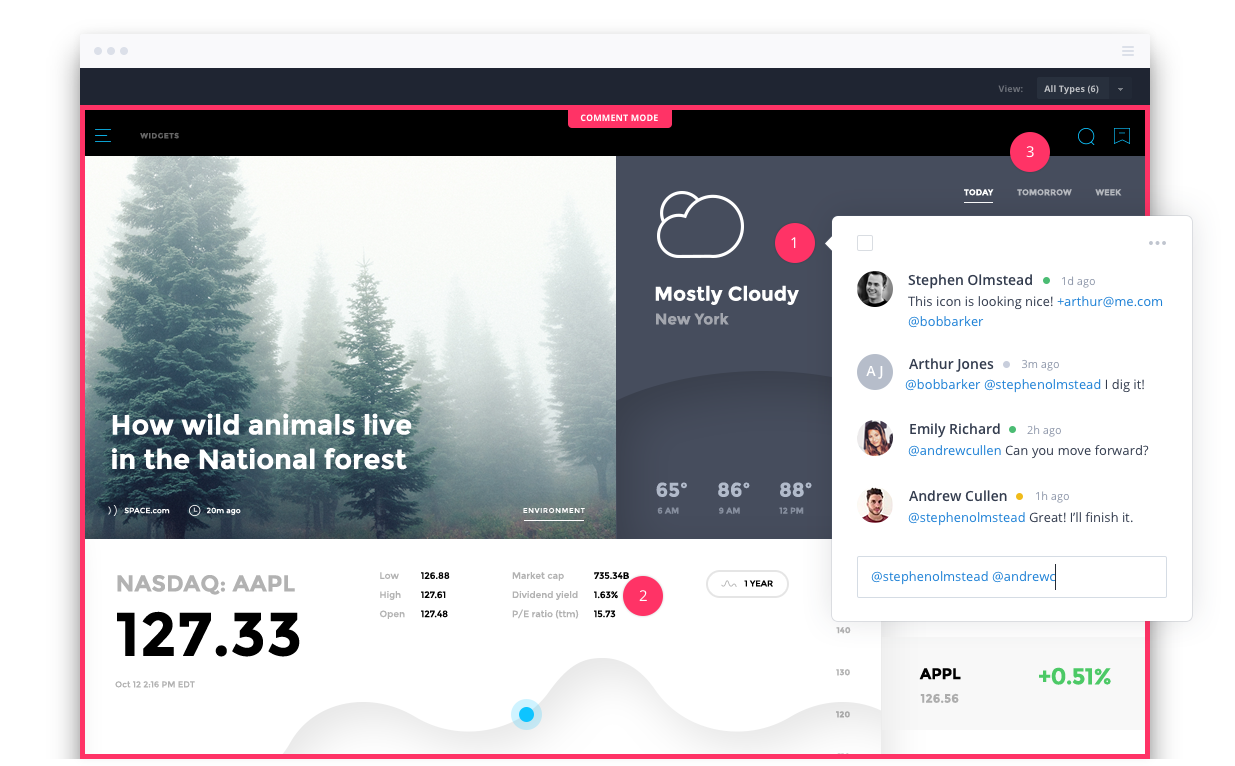
InVision champions simplified customer success milestones. Once the customer signs up for a free trial, it takes five simple steps for the user to be ready to complete their first project. Each step of a customer’s journey in InVison is focused on a single action, with other distractions eliminated.
Step #5: Continuously measure your and your customer’s health using an account health scorecard
As your customer progresses in their lifecycle, moving from one milestone to the next, you need a way of continuously assessing their health and the value they obtain from you.
For this, use an Account Health Scorecard. An account health scorecard will:
- Accurately capture the customer’s target objectives, target outcomes, and progress along their value realization path.
- Provide an advanced visual aid for users to understand product performance based on usage and business value creation.
- Track potential and emerging areas of concern and red-flag these as issues.
- Continuously measure the health of an account over time.
Your Account Health Scorecard will measure customer success efforts and compare these to your target milestones.
Use our Account Health Scorecard Checklist Workflow below to accurately determine the health of your customer’s accounts, your health, and customer progression from one milestone to the next.
Click here to access our Account Health Scorecard Checklist Workflow!
Key workflow features:
- Stop Tasks: Stop Tasks ensure the required steps for creating an accurate scorecard are completed in the correct order.
- File Upload and Approvals: You’ll be asked to upload the account scorecard you produce using our File Upload feature. Your manager is then notified that your scorecard is ready for assessment, and can jump in and accept/reject (with comments) as required using our Approvals feature. This gives an extra layer of quality control.
- Role Assignments: Use our Role Assignments feature to assign your supervisor to the approval task. Your supervisor will be automatically notified of the upcoming approval action required.
Step #6: Use product adoption and account expansion milestones
Product adoption means your product becomes integral to the customer’s daily activities and operations. According to Gainsight, it takes 90 days for your customer to realize clear value from your product. But without full product adoption, there’s little incentive for your customers to continue to use your product.
Measure customer use, activity, and success vectors to track product adoption. Also, dig into your churn data to pinpoint customers who’ve left because they didn’t get enough value from your product. Why weren’t they seeing value? Could you have done something to change that?
Determine which product features the customer is using most often to define your customer success initiatives. Focus on usage trends to gauge whether a customer has fully adopted your product, rather than short-term usage data.
In terms of expansion, this comes after your customers have fully adopted your product. Don’t stuff upselling and cross-selling opportunities into the face of your customers to extract revenue. If your customers aren’t getting more value, they’ll catch on, and when they do – boom you’ve lost their trust.
Instead, approach expansion to help your customers extract optimal value from your product.
The way that we do that is to create a customer experience that delivers increasing amounts of value over time, creating a natural growth in base-product use, a logical expansion into additional functionality, and where appropriate, adoption of adjacent products from your company. – Sixteen Ventures, Customer Success: The Definitive Guide to Customer-Centric Growth
Use data to launch intelligent expansion efforts, ones that truly deliver value to your customers.
Step #7: Use customer evangelism as a key milestone for your mature accounts
Your customers will learn to love your product, and at say milestone 20, 30, 50…you should have built a strong business-to-customer relationship. Your aim is to utilize this strong relationship to build a customer evangelist campaign for your product.
This will come as a later success milestone. It’s important not to push for evangelism too soon as this could break down customer trust.
For your more matured customers who’ve progressed substantially through their lifecycle, consider their account’s health – measured by using our Account Health Scorecard Checklist Workflow.
What you want are accounts that:
- Are healthy regarding business, experience, and performance value.
- Are mature, on a positive vector path, having successfully mastered the majority of their success milestones.
Evangelism has the customer’s best interests at heart, and effective customer evangelism starts with a great product that your users love.
Communicate and guide your customers towards their customer evangelist milestone. To help, use our Evangelist Sequence Email Process workflow to build a professional evangelist email sequence campaign.
Remember, customer evangelism is the ultimate customer loyalty.
Click here to access our Evangelist Sequence Email Process workflow!
Key workflow features:
- Conditional Logic: Conditional Logic makes the workflow dynamic and adaptable to your unique needs. In this case, the workflow can be adapted to run email campaigns of different lengths.
- Webhooks: Webhooks allow you to send information from the workflow directly to other apps. In this instance, you can send an email from the workflow to members of your team, coordinating teamwork.
Step #8: Use your success milestones to determine a product qualified lead (PQL)
A product-qualified lead (PQL) is a prospect that has realized initial value from your product. When a PQL shows enough interest, this will trigger your sales team to engage with that prospective customer. Defining PQL’s is vital if you’re wanting to take a product-oriented approach.
For instance, coming back to our Bruce Wayne hypothetical scenario. We could say that Bruce realized initial product value when he created and ran his first Process Street workflow. Bruce had to complete two milestones to get him to a PQL position.
- Milestone 1: Bruce completed a product demo.
- Milestone 2: Bruce signed up for a free Process Street account.
Under this scenario, a PQL for Process Street would be defined as:
Process Street PQL = Complete a product demo (milestone 1) + setup a Process Street account (milestone 2).
In a more traditional, non-customer-centric, and non-product oriented approach, the marketing department is in charge of nurturing leads until they’re ready to buy. Buying intent is determined by looking at an individual’s response to marketing messages.
A product-oriented approach, however, looks at in-product behavioral data to quantify buying intent.
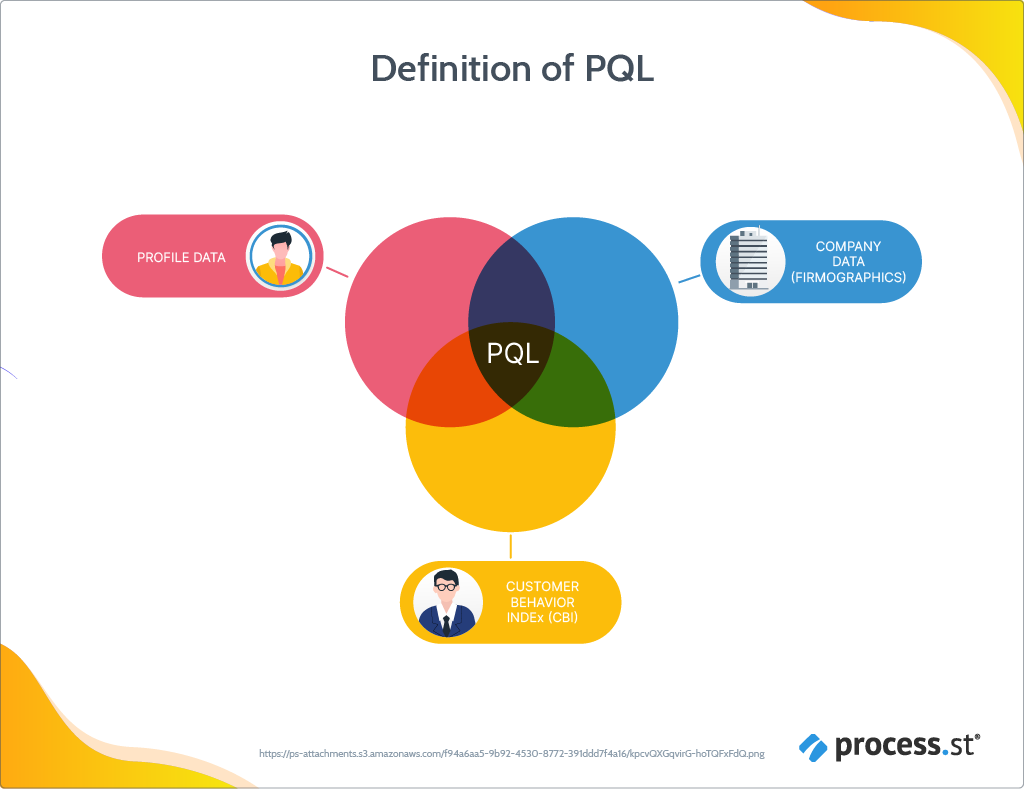
Your PQL is an aggregation of:
- Profile data: This is your target persona profile. In the Bruce Wayne example, this would include Wayne’s demographic information and pain points.
- Customer behavior: This is where your milestones come into the PQL scene. What milestones need to be completed for your prospect to become a PQL?
- Company data (firmographics): Your industry, location, size, status or structure, and performance will determine whether a customer can qualify as a prospect or not. Use company data to define your target persona.
You want to focus your attention and resources on your PQL’s. Ensuring your PQLs hit their milestones is a priority.
Choose milestones that support a product-oriented approach to customer success
Global digitization is altering the status-quo in business. To respond, organizations need to re-focus their strategy to be both customer-centric and product-oriented.
Mapping your customer’s lifecycle allows you to measure and track where the customer is heading. Next, mark customer success milestones onto this lifecycle. These milestones need to support a product-oriented approach, and the 8 steps given in this article will help you design customer success milestones accordingly.
If you’re looking to optimize your customer success operations, sign up for your free Process Street account. You can use our no-code workflows to delight your customers in every step of their journey.
We have a wealth of free pre-made workflows you can use today. Have a browse of our workflow library to find the workflows right for you and your aims.
In addition, check out our top customer success content. Read the articles below for more information on how to optimize your customer success processes.
- Complete Guide to Customer Success for SaaS Companies
- How to Have a Customer Health Score Beyond Just NPS (Which We Know 46% of You Use!)
- Customer Engagement: How to Keep Your Customers Hooked Throughout the Sales Cycle
- How to Manage a Successful CS Transformation to Be More Customer-Centric
- Customer Success 2.0: The Essential Software Stack to Execute McKinsey’s Model
Are your customer success efforts product-oriented? If not, why not? What challenges are you facing when trying to adopt this approach? We’d love to hear from you, please comment below!







 Workflows
Workflows Forms
Forms Data Sets
Data Sets Pages
Pages Process AI
Process AI Automations
Automations Analytics
Analytics Apps
Apps Integrations
Integrations
 Property management
Property management
 Human resources
Human resources
 Customer management
Customer management
 Information technology
Information technology



Jane Courtnell
Hi there, I am a Junior Content Writer at Process Street. I graduated in Biology, specializing in Environmental Science at Imperial College London. During my degree, I developed an enthusiasm for writing to communicate environmental issues. I continued my studies at Imperial College's Business School, and with this, my writing progressed looking at sustainability in a business sense. When I am not writing I enjoy being in the mountains, running and rock climbing. Follow me at @JaneCourtnell.